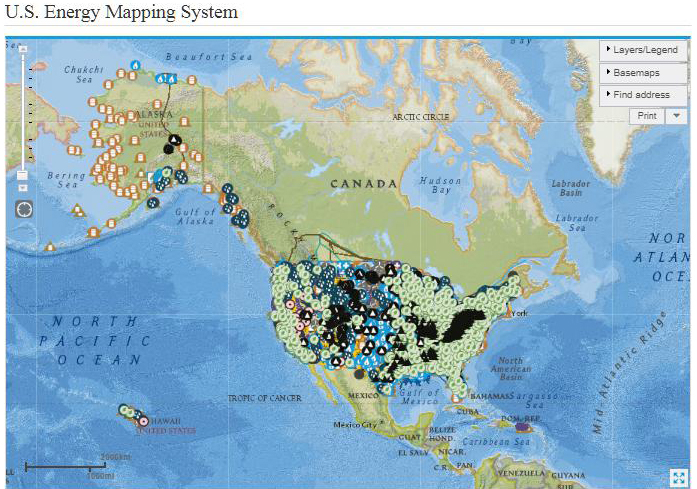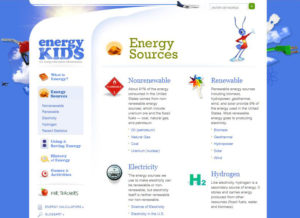Source
Aries Clean Energy
Publication Date
March 14, 2018
The website of the US Energy Information Administration has information on each state plus items for educators and students.
 There is a wealth of free energy information available on the worldwide web. The website of the U.S. Energy Information Administration (EIA) is one of these sites. It is the statistical and analytical agency within the U.S. Department of Energy. This agency collects, analyzes, and disseminates energy information to promote sound policymaking, efficient markets, and public understanding of energy and its interaction with the economy and the environment.
There is a wealth of free energy information available on the worldwide web. The website of the U.S. Energy Information Administration (EIA) is one of these sites. It is the statistical and analytical agency within the U.S. Department of Energy. This agency collects, analyzes, and disseminates energy information to promote sound policymaking, efficient markets, and public understanding of energy and its interaction with the economy and the environment.
EIA states that it is the nation’s premier source of energy information and, by law, its data, analyses, and forecasts are independent of approval by any other officer or employee of the U.S. government.
EIA conducts a comprehensive data collection program that covers the full spectrum of energy sources, end uses, and energy flows. EIA also prepares informative energy analyses, monthly short-term forecasts of energy market trends, and long-term U.S. and international energy outlooks. EIA disseminates its data, analyses, and other products primarily through its website, EIA.gov.
The information below highlights a few of the site’s contents.
Energy Information By State
By selecting a particular state, you will find sections that give you Quick Facts and Energy Consumption in that state. It also cites data in each state on petroleum, natural gas, coal, electricity, renewable energy complete with documentation.
Updates last month: State Energy Profiles have been updated with new monthly data, including series for electricity, petroleum, natural gas, and coal. Activities covered by those series include prices, supply, and consumption. In addition, new annual data are available for average temperature, precipitation, and vehicle miles traveled.
Profile Analyses and Quick Facts have been updated for four states. Users can learn facts such as the following:
- Arkansas is one of the top 10 natural gas-producing states, and holds almost 3% of the nation’s natural gas reserves.
- Louisiana’s 18 oil refineries account for nearly one-fifth of the nation’s refining capacity and are capable of processing more than 3.3 million barrels of crude oil per day.
- Nebraska ranked second in the nation, after Iowa, in corn-based ethanol production capacity in 2017, producing about 14% of the nation’s total.
- In 2016, North Dakota was the second-largest crude oil-producing state in the nation and accounted for 12% of total U.S. crude oil production, including oil produced in federal offshore areas.
In 2017, hydroelectric power provided more than two-fifths of South Dakota’s net electricity generation, the largest share of any energy source in the state.
State and Territory Energy Profiles provide Profile Analyses and Quick Facts for each of the 56 states and territories. In addition, the Profiles offer 81 key data series for each state, including state rankings for 10 of the data series.
Energy Information for Educators

Teachers can find information on energy lesson plans, field trips, glossary, careers, science fair experiments, etc., for grades K-12. on the site. Also of interest is an energy calculator. This converts one energy unit into another, for example, converting Btu to Kilowatt hours or megajoules.
https://www.eia.gov/kids/energy.cfm?page=6
Energy Information for Kids

A special section for the young includes ways to save and use energy wisely. Also included is a brief history on energy, energy sources, plus games and activities.
https://www.eia.gov/kids/index.cfm
US Energy Mapping System
https://www.eia.gov/state/maps.php
The interactive maps located here allow you to zero in on a particular state or area. The map legends will tell you what kind of energy plant is located there, its technology, primary fuel, and capacity among other facts.
About EIA.gov
The website, EIA.gov, is the primary communication channel for the U.S. Energy Information Administration (EIA) and serves as the agency’s worldwide energy information point of contact for:
- Federal, state, and local governments
- The academic and research communities
- Businesses and industry
- Foreign governments and international organizations
- The news media
- Financial institutions
- The general public
EIA Offices
The Office of Resource and Technology Management directs a variety of centralized and cross-cutting corporate business activities including EIA’s independent information technology infrastructure and data center operation, budget and financial management, procurement oversight and processing, human capital management, and logistical support. This Office also provides expert advice to the Administrator on strategic planning and program evaluation, agency business and technology policy, physical and technology security, and financial analysis and evaluation in support of EIA strategic goals and objectives.
The Office of Energy Statistics conducts a wide range of survey, statistical methods, and integration activities related to: energy consumption and efficiency; electricity; nuclear and renewable energy; oil, gas and coal supply; and petroleum and biofuels. This Office also manages the EIA data collection program and the quality control for weekly, monthly, quarterly, annual and quadrennial statistical reports.
The Office of Energy Analysis analyzes energy supply, demand, and prices including the impact of financial markets on energy markets; prepares reports on current and future energy use; analyzes the impact of energy policies; and develops advanced techniques for conducting energy information analyses. This Office also oversees the planning and execution of EIA’s analysis and forecasting programs to ensure that EIA models, analyses, and projections meet the highest standards of relevance, reliability, and timeliness.
The Office of Communications oversees a comprehensive energy information dissemination program that provides high quality information in a timely manner that can be accessed by all types of EIA’s public and private audiences. This Office also oversees the application of web-based technology to successfully execute the EIA mission and serve the agency’s extensive customer base.
The Department of Energy Organization Act of 1977 established EIA as the primary federal government authority on energy statistics and analysis. Located in Washington, DC, EIA is an organization of about 370 federal employees, with an annual budget in Fiscal Year 2016 of $122 million.


